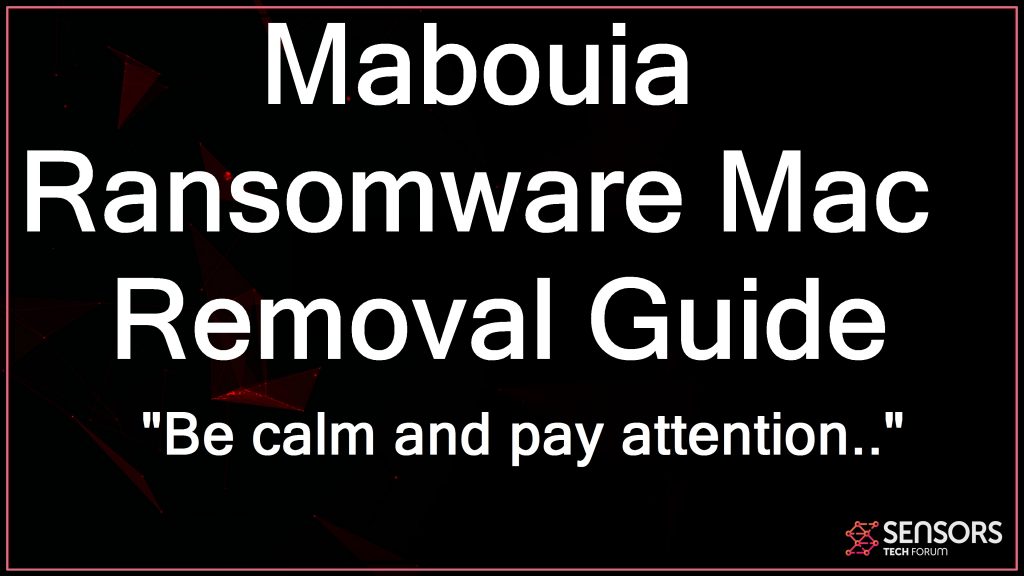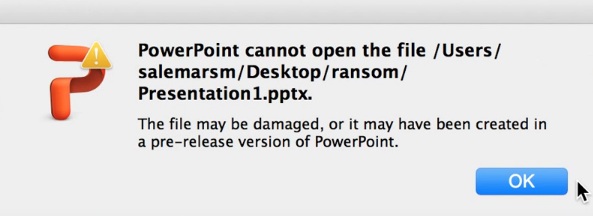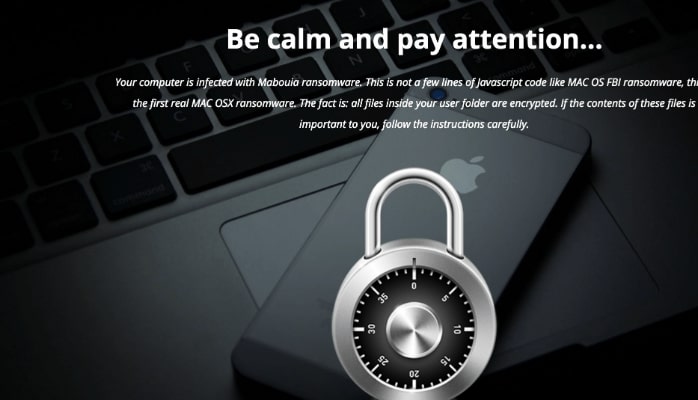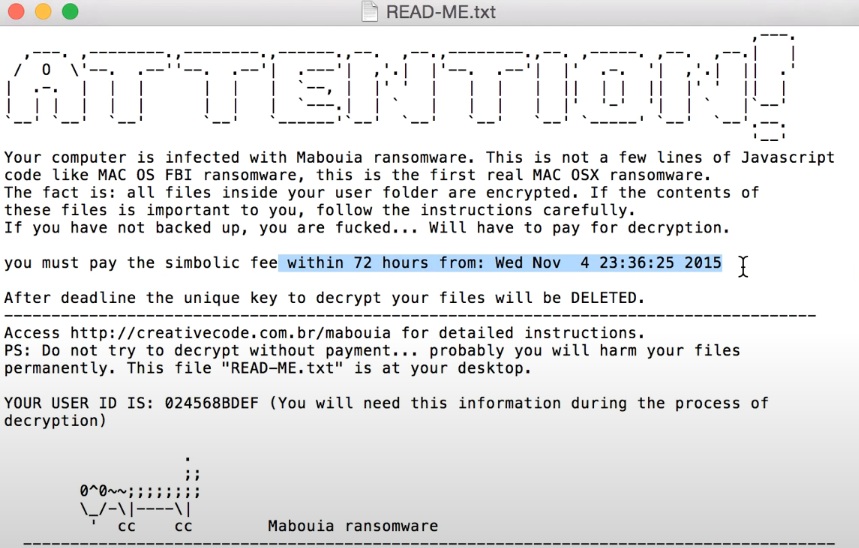What is Mabouia Ransomware?
 Mabouia Ransomware is the first cryptovirus infection for Mac. This means that this virus enters your Mac and targets your important files. Then, it encrypts them, using a sophisticated file encryption algorithm. To recover the files, this virus wants you to pay a hefty ransom fee possibly in the anonymous cryptocurrency BitCoin.
Mabouia Ransomware is the first cryptovirus infection for Mac. This means that this virus enters your Mac and targets your important files. Then, it encrypts them, using a sophisticated file encryption algorithm. To recover the files, this virus wants you to pay a hefty ransom fee possibly in the anonymous cryptocurrency BitCoin.
Read this article to learn more about how Mabouia ransomware operates and how you can remove it from your Mac and try to restore your important files.

Mabouia Summary
| Name | Mabouia |
| File Extension | READ-ME.txt |
| Type | The first cryptovirus for Mac. |
| Short Description | Aims to encrypt your files and hold them hostage until you pay $500 ransom to get them to work again. |
| Symptoms | The Mabouia ransomware will encrypt your files by appending its own extension to them. |
| Ransom Demanding Note | _readme.txt |
| Distribution Method | Spam Emails, Email Attachments |
| Detection Tool |
See If Your System Has Been Affected by malware or other threats. Download
Malware Removal Tool
|
User Experience | Join Our Forum to Discuss Mabouia Virus. |
Mabouia Virus Mac – More Information
Just like other ransomware viruses, Mabouia ransomware may also enter your Mac by being sent to you as an e-mail attachment that is uploaded as an important document that is added to the e-mail and portrayed as a must-see type of file. The primary idea of these files is to convince users that they are an importan invoice, flight ticket or something else. Once the file is downloaded and ran on your Mac, you may become infected with this virus.
Another possible infection scenario with this virus includes downloading the infection file of the ransomware as a fake app. Some low reputation or compromised websites may offer fake apps for download. The case here is instead of getting the original app, you become infected with the virus instead.
Once the Mabouia virus is added to your Mac, it may run a procesa as administrator in the Activity Monitor. This process may begin to scan your computer for the following types of files:
- Images.
- Videos.
- Audio files.
- Archives.
- Virtual drives.
After encryption, the files cannot be opened by your Mac, like shown in the image below:
Text in the pop-up is the following:
%ProgramName% cannot open the file /Users/username/Desktop/
The file may be damaged, r it may have been created in a pre-releaese version of %ProgramName%
The malware does not encrypt your macOS system files. This is done with the main purpose to allow you to still use your Mac to pay the ransom.
After encrypting your files this nasty virus may leave a ransom note file. In a normal scenario, it may ask you to pay ransom, but according to its creator Rafael Salema Marques, this virus may only be there to raise awareness that your Mac is not exactly safe.
The ransom note file looks like the following:
The text from the note is the following:
Be calm and pay attention…
Your computer is infected with Mabouia ransomwware. This is not a few lines of javascript code like MAC OS FBI ransomware,
the first real MAC OSX ransomware. The fact is: ail files inside your user folder are encrypted. If the contents of these files is
important to you, follow the instructions carefully.
The virus also drops a second ransom note that contains a text and is called READ-ME.txt. It looks like the following:
Text from image:
Your computer is infected with Mabouia ransomware. This is not a few lines of Javascript
code like MAC OS FBI ransomware, this is the first real MAC OSX ransomware.
The fact is: all files inside your user folder are encrypted. If the contents of
these files is important to you, follow the instructions carefully.If you have not backed up, you are fucked… Will have to pay for decryption.
You must pay the simbolic fee within 72 hours from: Wed Nov 4 23:36:25 2015 I
After deadline the unique key to decrypt your files will be DELETED.
Access http://creativecode.com.br/mabouia for detailed instructions.PS: Do not try to decrypt without payment… probably you will harm your files
permanently. This file “READ-ME.txt” is at your desktop.
YOUR USER ID IS: 024568BDEF (You will need this information during the process of
decryption)
According to securityaffairs.co, the researcher had the following to say:
The researcher’s goal is to alert the 66 million users of Mac OS X about the myth that there is no malware aimed at Apple’s personal computers.
The files that are encrypted by this ransomware are encoded via the XTEA encryption algorithm which allows this infection to happen if you perform just one click.

Remove Mabouia Ransomware and Try Restoring Files
Since this virus has been detected in the wild, that means someone may be spreading it and infecting users. If you happen to be a victim of this ransomware, the we strongly recommend that you read the steps below to remove this threat safely and try to get your files back. For the best removal, we strongly reccomend to download a professional anti-malware app. Such app will make sure that you detect and get rid of Mabouia virus files effectively and stop such threats in the future as well.
To try and recover files, infected by this nasty malware, we strongly recommend that you follow the “file restore” instructions, posted underneath. They have been created with the main reason to help you recover as many files as possible on your Mac, but they are no guarantee that you can restore all files.
- Step 1
- Step 2
- Step 3
- Step 4
- Step 5
Step 1: Scan for Mabouia Virus with SpyHunter Anti-Malware Tool



Ransomware Automatic Removal - Video Guide
Step 2: Uninstall Mabouia Virus and related malware from Windows
Here is a method in few easy steps that should be able to uninstall most programs. No matter if you are using Windows 10, 8, 7, Vista or XP, those steps will get the job done. Dragging the program or its folder to the recycle bin can be a very bad decision. If you do that, bits and pieces of the program are left behind, and that can lead to unstable work of your PC, errors with the file type associations and other unpleasant activities. The proper way to get a program off your computer is to Uninstall it. To do that:


 Follow the instructions above and you will successfully delete most unwanted and malicious programs.
Follow the instructions above and you will successfully delete most unwanted and malicious programs.
Step 3: Clean any registries, created by Mabouia Virus on your computer.
The usually targeted registries of Windows machines are the following:
- HKEY_LOCAL_MACHINE\Software\Microsoft\Windows\CurrentVersion\Run
- HKEY_CURRENT_USER\Software\Microsoft\Windows\CurrentVersion\Run
- HKEY_LOCAL_MACHINE\Software\Microsoft\Windows\CurrentVersion\RunOnce
- HKEY_CURRENT_USER\Software\Microsoft\Windows\CurrentVersion\RunOnce
You can access them by opening the Windows registry editor and deleting any values, created by Mabouia Virus there. This can happen by following the steps underneath:


 Tip: To find a virus-created value, you can right-click on it and click "Modify" to see which file it is set to run. If this is the virus file location, remove the value.
Tip: To find a virus-created value, you can right-click on it and click "Modify" to see which file it is set to run. If this is the virus file location, remove the value.
Before starting "Step 4", please boot back into Normal mode, in case you are currently in Safe Mode.
This will enable you to install and use SpyHunter 5 successfully.
Step 4: Boot Your PC In Safe Mode to isolate and remove Mabouia Virus





Step 5: Try to Restore Files Encrypted by Mabouia Virus.
Method 1: Use STOP Decrypter by Emsisoft.
Not all variants of this ransomware can be decrypted for free, but we have added the decryptor used by researchers that is often updated with the variants which become eventually decrypted. You can try and decrypt your files using the instructions below, but if they do not work, then unfortunately your variant of the ransomware virus is not decryptable.
Follow the instructions below to use the Emsisoft decrypter and decrypt your files for free. You can download the Emsisoft decryption tool linked here and then follow the steps provided below:
1 Right-click on the decrypter and click on Run as Administrator as shown below:

2. Agree with the license terms:

3. Click on "Add Folder" and then add the folders where you want files decrypted as shown underneath:

4. Click on "Decrypt" and wait for your files to be decoded.

Note: Credit for the decryptor goes to Emsisoft researchers who have made the breakthrough with this virus.
Method 2: Use data recovery software
Ransomware infections and Mabouia Virus aim to encrypt your files using an encryption algorithm which may be very difficult to decrypt. This is why we have suggested a data recovery method that may help you go around direct decryption and try to restore your files. Bear in mind that this method may not be 100% effective but may also help you a little or a lot in different situations.
Simply click on the link and on the website menus on the top, choose Data Recovery - Data Recovery Wizard for Windows or Mac (depending on your OS), and then download and run the tool.
Mabouia Virus-FAQ
What is Mabouia Virus Ransomware?
Mabouia Virus is a ransomware infection - the malicious software that enters your computer silently and blocks either access to the computer itself or encrypt your files.
Many ransomware viruses use sophisticated encryption algorithms to make your files inaccessible. The goal of ransomware infections is to demand that you pay a ransom payment to get access to your files back.
What Does Mabouia Virus Ransomware Do?
Ransomware in general is a malicious software that is designed to block access to your computer or files until a ransom is paid.
Ransomware viruses can also damage your system, corrupt data and delete files, resulting in the permanent loss of important files.
How Does Mabouia Virus Infect?
Via several ways.Mabouia Virus Ransomware infects computers by being sent via phishing emails, containing virus attachment. This attachment is usually masked as an important document, like an invoice, bank document or even a plane ticket and it looks very convincing to users.
Another way you may become a victim of Mabouia Virus is if you download a fake installer, crack or patch from a low reputation website or if you click on a virus link. Many users report getting a ransomware infection by downloading torrents.
How to Open .Mabouia Virus files?
You can't without a decryptor. At this point, the .Mabouia Virus files are encrypted. You can only open them once they are decrypted using a specific decryption key for the particular algorithm.
What to Do If a Decryptor Does Not Work?
Do not panic, and backup the files. If a decryptor did not decrypt your .Mabouia Virus files successfully, then do not despair, because this virus is still new.
Can I Restore ".Mabouia Virus" Files?
Yes, sometimes files can be restored. We have suggested several file recovery methods that could work if you want to restore .Mabouia Virus files.
These methods are in no way 100% guaranteed that you will be able to get your files back. But if you have a backup, your chances of success are much greater.
How To Get Rid of Mabouia Virus Virus?
The safest way and the most efficient one for the removal of this ransomware infection is the use a professional anti-malware program.
It will scan for and locate Mabouia Virus ransomware and then remove it without causing any additional harm to your important .Mabouia Virus files.
Can I Report Ransomware to Authorities?
In case your computer got infected with a ransomware infection, you can report it to the local Police departments. It can help authorities worldwide track and determine the perpetrators behind the virus that has infected your computer.
Below, we have prepared a list with government websites, where you can file a report in case you are a victim of a cybercrime:
Cyber-security authorities, responsible for handling ransomware attack reports in different regions all over the world:
Germany - Offizielles Portal der deutschen Polizei
United States - IC3 Internet Crime Complaint Centre
United Kingdom - Action Fraud Police
France - Ministère de l'Intérieur
Italy - Polizia Di Stato
Spain - Policía Nacional
Netherlands - Politie
Poland - Policja
Portugal - Polícia Judiciária
Greece - Cyber Crime Unit (Hellenic Police)
India - Mumbai Police - CyberCrime Investigation Cell
Australia - Australian High Tech Crime Center
Reports may be responded to in different timeframes, depending on your local authorities.
Can You Stop Ransomware from Encrypting Your Files?
Yes, you can prevent ransomware. The best way to do this is to ensure your computer system is updated with the latest security patches, use a reputable anti-malware program and firewall, backup your important files frequently, and avoid clicking on malicious links or downloading unknown files.
Can Mabouia Virus Ransomware Steal Your Data?
Yes, in most cases ransomware will steal your information. It is a form of malware that steals data from a user's computer, encrypts it, and then demands a ransom in order to decrypt it.
In many cases, the malware authors or attackers will threaten to delete the data or publish it online unless the ransom is paid.
Can Ransomware Infect WiFi?
Yes, ransomware can infect WiFi networks, as malicious actors can use it to gain control of the network, steal confidential data, and lock out users. If a ransomware attack is successful, it could lead to a loss of service and/or data, and in some cases, financial losses.
Should I Pay Ransomware?
No, you should not pay ransomware extortionists. Paying them only encourages criminals and does not guarantee that the files or data will be restored. The better approach is to have a secure backup of important data and be vigilant about security in the first place.
What Happens If I Don't Pay Ransom?
If you don't pay the ransom, the hackers may still have access to your computer, data, or files and may continue to threaten to expose or delete them, or even use them to commit cybercrimes. In some cases, they may even continue to demand additional ransom payments.
Can a Ransomware Attack Be Detected?
Yes, ransomware can be detected. Anti-malware software and other advanced security tools can detect ransomware and alert the user when it is present on a machine.
It is important to stay up-to-date on the latest security measures and to keep security software updated to ensure ransomware can be detected and prevented.
Do Ransomware Criminals Get Caught?
Yes, ransomware criminals do get caught. Law enforcement agencies, such as the FBI, Interpol and others have been successful in tracking down and prosecuting ransomware criminals in the US and other countries. As ransomware threats continue to increase, so does the enforcement activity.
About the Mabouia Virus Research
The content we publish on SensorsTechForum.com, this Mabouia Virus how-to removal guide included, is the outcome of extensive research, hard work and our team’s devotion to help you remove the specific malware and restore your encrypted files.
How did we conduct the research on this ransomware?
Our research is based on an independent investigation. We are in contact with independent security researchers, and as such, we receive daily updates on the latest malware and ransomware definitions.
Furthermore, the research behind the Mabouia Virus ransomware threat is backed with VirusTotal and the NoMoreRansom project.
To better understand the ransomware threat, please refer to the following articles which provide knowledgeable details.
As a site that has been dedicated to providing free removal instructions for ransomware and malware since 2014, SensorsTechForum’s recommendation is to only pay attention to trustworthy sources.
How to recognize trustworthy sources:
- Always check "About Us" web page.
- Profile of the content creator.
- Make sure that real people are behind the site and not fake names and profiles.
- Verify Facebook, LinkedIn and Twitter personal profiles.
















